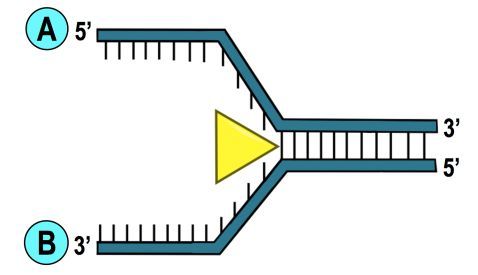Now, DNA replication can be simplified into six steps. Step 1 involves the enzyme helicase. Helicase binds and unwinds the two strands of the template DNA by breaking hydrogen bonds. If you come down here in the image, we're first going to label the 5' and 3' ends of our DNA template strands. We're going to say up here is our 5' and if we follow this, here, this will be 3'. If this is 5', this would have to be 3'. This would have to be 5'. Then, coming down here, if we follow this, we can see that this trend here would be 5' and therefore, this would have to be 3'. So these are the ends of our DNA strands.
We're talking about Step 1 where helicase is going to cut through our hydrogen bonds between the nitrogenous bases. So, we can see here that these hydrogen bonds are broken with a bang by the helicase enzyme. It slices through them, opening up the DNA double helix so that replication can commence.
Now, here for Step 2, we have our stabilizing proteins. Here, they're going to bind to and stabilize the single-stranded DNA. DNA wants to maintain these hydrogen bonds, but we have these stabilizing proteins which come in and force it to stay open long enough so that DNA replication can proceed. Remember, they're represented by these orange spheres. So, this would be Step 2.
Next, we have Step 3, which deals with primase, our enzyme. Primase adds the RNA primer to the template DNA so that polymerase can start replicating. Now, if we come down here, we see primase adding down these primers. We have one here, here, here, and here. And it's important here that we're going to continuously add primers to the lagging strand to make several Okazaki fragments. Remember, the lagging strand goes in the opposite direction of the replication fork movement. Because of this, we're going to have to continuously add primers to make our new DNA strands, and this is just the way it has to be.
Now we have DNA polymerase, which has two functions. First, it adds new DNA nucleotides in the 5' to 3' direction. So here, this would be Step 4. We're adding in the 5' to 3' direction. So, since this is the 3' end, and the strands have to be antiparallel in order to be complementary, we're going to say here that this is the 5' to 3' end in which we lay down our new DNA.
The second function of DNA polymerase is that it removes RNA primers and replaces them with DNA. So, we're going to say here, Step 5, there's this primer here; this polymerase will also replace that primer in order to add in new DNA. These pink portions and all other pink portions are eventually going to be removed by DNA Polymerase.
And finally, Step 6, we have DNA ligase which links Okazaki fragments together on the lagging strand to create a single new DNA strand. Remember, there are gaps that we have between our Okazaki fragments. Step 6, our ligase comes in; it kind of fills in these gaps here. So, we have one strand of new DNA just like we have our leading strand up here that's all one strand of DNA.
Right, so when we talk about DNA replication, we can talk about it in reference to these six major steps, which incorporate different enzymes and proteins in order for DNA replication to be successful. So, again, just remember, from helicase all the way down to ligase, they all have a job in order to get new DNA, new daughter strands to be created from our DNA template strands.


